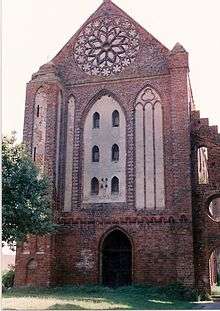Kołbacz Abbey
The Kołbacz Abbey was a Cistercian monastery located in Kołbacz, Poland. It had several subsidiaries, with the other main centers located in Oliwa, Bierzwnik, and Mironice. It was itself a subsidiary of Clairvaux Abbey, Ville-sous-la-Ferté, although the funding monks originally arrived from the Danish Esrum Abbey in Zealand.

The abbey was founded in 1173 with the original Latin name "Mera Vallis", but eventually the older Slavic name, Kołbacz became closely associated with the place. The monks were invited into Pomerania by Warcisław II Świętoborzyc,[1] a castellan of Szczecin, as part of an agreement with Valdemar I of Denmark, who had besieged Szczecin and made Warcisław his vassal. The foundation was affirmed by Duke Bogusław I in 1173. The first abbot was Reinhold and the abbey began its activities in 1174.[2]
The wealth of the Abbey was based on banking, as much as land ownership.[3]
The abbey played an important role in the development of German settlements in the area, as the first villages of German-speaking inhabitants were founded close to the abbey. [4]
Currently it is the site of an agricultural complex near Szczecin, which partly houses the Zoological Experimental Institute of the Kraków Technical Institute.
References
- Janet E. Burton; Karen Stöber, eds. (July 17, 2008). Monasteries and Society in the British Isles in the Later Middle Ages - Google Books. Boydell & Brewer Ltd. p. 256. ISBN 978-1843833864. Retrieved 2014-08-19.
- Steinar Imsen, ed. (2010). The Norwegian Domination and the Norse World, C.1100-c.1400 - Google Books. Tapir Academic Press. ISBN 978-83-7469-479-7. Retrieved 2014-08-19.
- Jasienica, Pawel (2007). Polska Piastow. Proszynski i s-ka. p. 295. ISBN 978-8251925631.
- Elżbieta Foster, Cornelia Willich, Torsten Kempke (2007). Ortsnamen und Siedlungsentwicklung: das nördliche Mecklenburg im Früh- und Hochmittelalter (in German). Steiner. p. 36.CS1 maint: uses authors parameter (link)